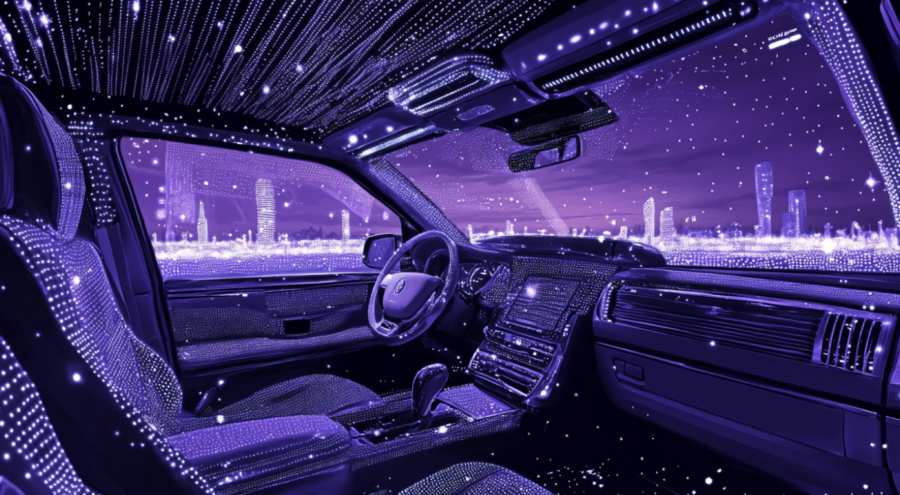Why Light Matters More Than We Admit
Most people think of cabin lighting as an afterthought, something toggled between “on,” “off,” and “please don’t let anyone see me eating this sandwich.” Yet lighting has measurable influence on circadian rhythms, mental clarity, perceived temperature, and even the likelihood of accidental mid-meeting naps. Chauffeured vehicles are ideal playgrounds for dynamic lighting because passengers are free from driving responsibilities and far more open to environmental cues.Properly tuned hues can bring a sense of order to a chaotic schedule. Softer, warmer light can help deflate a stressful afternoon, while cooler tones sharpen attention for those preparing for a meeting. Many systems now combine micro-LED arrays with ambient sensors that track motion, temperature, time of day, and even posture, adjusting illumination discreetly.
The Sensors Secretly Running the Show
Sensors tucked behind trim pieces work tirelessly to interpret the passenger’s immediate needs. Instead of constantly tweaking a panel of sliders, you sit back while the car quietly decides whether you look like someone who needs serenity or caffeine manifested as photons.These systems often reference a small collection of factors:
- Movement patterns that indicate restlessness or fatigue
- External brightness levels that affect perceived comfort
- Temperature shifts that hint at rising tension
- Time-of-day data that predicts mental alertness
Personalization Without the Fuss
Personalization profiles allow passengers to store preferred lighting moods. Some riders favor subtle transitions so smooth they resemble a friendly nudge, while others choose bolder patterns that declare, quite assertively, that they are absolutely not ready for any social interaction before their second espresso. Chauffeur fleets increasingly sync these preferences across vehicles, ensuring consistency regardless of which car arrives.The magic lies in creating familiarity without slipping into monotony. By learning patterns—your typical work hours, meeting days, and relaxation windows—the system offers curated environments that feel tailored but not overly choreographed.
Energizing, Focusing, and Occasionally Saving You From Yourself
Sometimes the cabin needs to behave like a polite coach who knows when to offer encouragement and when to simply dim the world. For passengers preparing notes on a tight deadline, brighter cool-toned light can sharpen concentration. It’s surprising how something as simple as shifting from a mellow amber to a crisp blue-white can prompt the brain to stop meandering toward idle thoughts about lunch.These environments can also counteract the slump that arrives during long rides. A gradual, almost imperceptible elevation of brightness keeps the mind alert without feeling interrogated by a spotlight. Meanwhile, carefully placed accent lights reduce eye strain for those juggling screens, notebooks, or the existential dread of productivity apps.
For those moments when you’re drifting toward an accidental nap mid-conversation, some systems gently increase color saturation to invite wakefulness. There’s no judgment—just a nudge that says, “Perhaps now is not the time for unconsciousness.”
Designing Cabins That Feel Alive
Designers are increasingly shaping interiors around the behavior of light rather than treating lighting as an accessory. Materials with subtle reflectivity allow gradients to bloom across the cabin. Matte finishes soften transitions, ensuring nothing feels glaring or theatrical when subtlety is the goal. Even stitching and trim placement can influence how ambient color distributes around corners, creating a sense of continuity.By building interiors that assume lighting will shift moment to moment, manufacturers create cabins that behave almost like adaptive habitats. The car becomes less an object and more an environment—responsive, quietly observant, and sometimes surprisingly flattering when your face meets an unexpected shimmer of cool illumination.
When Technology Gets Playful
Of course, not everything has to be solemn. Some passengers program whimsical settings for special occasions. Celebratory color sweeps can make a mundane airport pickup feel like returning from a successful moon landing, even if the only mission accomplished was finding your luggage in under five minutes.Other configurations support shared rides: group profiles that shift to neutral, welcoming tones so no one feels like they’ve stepped into someone else’s emotional bubble. And while these playful features remain optional, they hint at how lighting can become part of a rider’s identity—expressive yet unobtrusive.
A Glow to Carry You Forward
As lighting grows more intelligent, it becomes an unspoken companion during travel. These systems are not about spectacle; they aim to restore attention, relieve strain, or stabilize mood. They support the quiet moments between destinations, those intervals when the mind wanders, recalibrates, or rehearses what comes next.Whether you’re unwinding after a demanding day or gearing up for something important, adaptive light choices smooth the transition. In a world that often feels louder than it needs to be, stepping into a cabin that already understands your emotional bandwidth can feel like the most understated luxury of all.
Light at the End of the Car Ride
Future chauffeur cabins will treat illumination as more than ambient decoration. They’ll offer subtle companionship, gentle encouragement, and occasional mischief, all while respecting the stillness that passengers sometimes crave. As designers refine these ecosystems, the humble glow along a door panel may become one of the most meaningful parts of modern travel—guiding attention, easing tension, and making each journey feel just a little more attuned to being human.Article kindly contributed by londonvipchauffeur.com – providers of londonvipchauffeur.com/corporate-chauffeur-london

